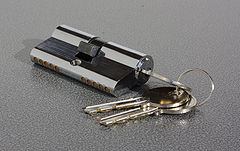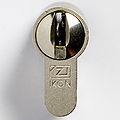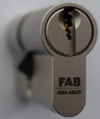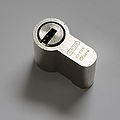Euro Profile: Difference between revisions
m (→Gallery: add euro cylinder side view) |
(link to Plug_follower) |
||
| (2 intermediate revisions by one other user not shown) | |||
| Line 17: | Line 17: | ||
==Disassembly instructions== | ==Disassembly instructions== | ||
Disassembly steps may vary slightly by design and manufacturer. The use of a [[pinning shoe]] is the preferred method for disassembling a typical double euro cylinder. Another method is to use a [[segmented follower]]. The c-clips retaining both cores must first be removed and then both cores can be pulled out slightly in order to remove the center cam. One core should be rotated to approximately 4:30 or 7:30 o'clock position -- 135 degrees either clockwise or counter-clockwise -- once the cam is removed. This allows the core to be removed without driver pins entering gaps for the cam clutch. At that point, a segmented follower can be used to remove the core. | Disassembly steps may vary slightly by design and manufacturer. The use of a [[pinning shoe]] is the preferred method for disassembling a typical double euro cylinder. Another method is to use a [[Plug_follower |segmented follower]]. The c-clips retaining both cores must first be removed and then both cores can be pulled out slightly in order to remove the center cam. One core should be rotated to approximately 4:30 or 7:30 o'clock position -- 135 degrees either clockwise or counter-clockwise -- once the cam is removed. This allows the core to be removed without driver pins entering gaps for the cam clutch. At that point, a segmented follower can be used to remove the core. | ||
Locks not intended for installation and use can be disassembled in a quick but destructive procedure. The cylinder housing itself can be cut in the middle using a hacksaw or grinder. The cam will no longer be held in place and can be removed. The resulting two cut half euro cylinders can then be disassembled as outlined above. | Locks not intended for installation and use can be disassembled in a quick but destructive procedure. The cylinder housing itself can be cut in the middle using a hacksaw or grinder. The cam will no longer be held in place and can be removed. The resulting two cut half euro cylinders can then be disassembled as outlined above. | ||
| Line 27: | Line 27: | ||
== Gallery == | == Gallery == | ||
<div align="center"><gallery> | <div align="center"><gallery> | ||
File:IKON WSW keyway - FXE47518.jpg | IKON WSW euro profile cylinder keyway | File:IKON WSW keyway - FXE47518.jpg | [[IKON WSW]] euro profile cylinder keyway | ||
File:cylinder - euro profile - FXE47645.jpg | Euro profile cylinder side view | File:cylinder - euro profile - FXE47645.jpg | Euro profile cylinder side view | ||
File:Euro_profile_cylinder_assembled.jpg|A Euro Profile cylinder mounted on a low-security indoor lock box. | File:Euro_profile_cylinder_assembled.jpg|A Euro Profile cylinder mounted on a low-security indoor lock box. | ||
File:FAB4xxxx_least.png | [[FAB_3***/4****|FAB Profi]] euro cylinder front view | |||
File:ABUS EC700 cut euro cylinder - FXE47684.jpg | [[ABUS EC700]] cut euro cylinder | |||
</gallery></div> | </gallery></div> | ||
Latest revision as of 22:03, 22 December 2022
Euro Profile
| Euro profile | |
 | |
| Name | Euro profile |
|---|---|
| Lock Type | Cylinder |
European profile (or Euro profile) is a type of cylinder design predominately used in Europe. Unlike traditional mortise and rim cylinders, the Euro profile uses a single piece of metal to connect both sides of the lock. A single cam component is placed between the two sides of the lock and is directly connected to both plugs. The Euro profile is convenient to install and replace, but it has some serious security shortcomings that must be taken into consideration. See Euro Profile (Vulnerabilities) for additional information.
Principles of operation
The Euro profile has several unique characteristics when compared with other cylinder designs. In particular, many designs only allow one side to engage the cam at any given time. This allows the owner of a double sided Euro profile lock to insert a key on the inner side to engage the cam and prevent it from being opened with a key on the outer side.
Disassembly instructions
Disassembly steps may vary slightly by design and manufacturer. The use of a pinning shoe is the preferred method for disassembling a typical double euro cylinder. Another method is to use a segmented follower. The c-clips retaining both cores must first be removed and then both cores can be pulled out slightly in order to remove the center cam. One core should be rotated to approximately 4:30 or 7:30 o'clock position -- 135 degrees either clockwise or counter-clockwise -- once the cam is removed. This allows the core to be removed without driver pins entering gaps for the cam clutch. At that point, a segmented follower can be used to remove the core.
Locks not intended for installation and use can be disassembled in a quick but destructive procedure. The cylinder housing itself can be cut in the middle using a hacksaw or grinder. The cam will no longer be held in place and can be removed. The resulting two cut half euro cylinders can then be disassembled as outlined above.
Vulnerabilities
The design of the Euro Profile cylinder leaves it vulnerable to a number of attacks. The placement of the cam in the center of the cylinder leave it especially vulnerable to destructive attacks, particularly prying and pulling.
Gallery
IKON WSW euro profile cylinder keyway
FAB Profi euro cylinder front view
ABUS EC700 cut euro cylinder
See also
| This article is a stub. You can help Lockwiki by expanding it. |





